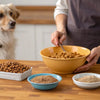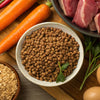Can You Feed Your Dog Raw Meat and Kibble? Understanding Mixed Feeding for Optimal Health
- Houndsy
Table of Contents
- Introduction
- Understanding Mixed Feeding
- The Myths Behind Mixing Raw and Kibble
- How to Safely Mix Raw Meat and Kibble
- Navigating Digestive Health
- Potential Challenges of Mixed Feeding
- Conclusion
Introduction
Did you know that nearly 70% of dog owners consider their pet's diet as crucial to their overall health? As pet parents, we often find ourselves navigating the complexities of canine nutrition, trying to provide the best food for our furry friends. With the rise of raw feeding and the enduring popularity of kibble, a common question arises: can you feed your dog raw meat and kibble? The short answer is yes, but the details are essential for ensuring your dog’s health and well-being.
In this blog post, we'll explore the nutritional benefits, potential challenges, and practical strategies of mixing raw meat with kibble. We'll cover why some pet owners choose this method, how to do it safely, and what ratios might work best for your dog. By the end of this article, you’ll have a clearer understanding of mixed feeding and how to enhance your dog’s diet while keeping their digestive health in mind.
As we embark on this journey, we invite you to reflect on your current pet feeding routine. Are you considering a switch to raw, or are you simply looking to enhance your dog’s kibble with fresh ingredients? Let’s dive in and discover how mixed feeding can elevate your dog’s dining experience.
Understanding Mixed Feeding
What is Mixed Feeding?
Mixed feeding refers to the practice of combining different types of dog food in one meal or across different meals. This typically involves feeding a combination of raw meat (or raw food in general) and kibble (dry dog food). The idea is to provide the nutritional benefits of raw food while leveraging the convenience of kibble.
Why Choose Mixed Feeding?
- Nutritional Variety: Providing a mix of raw meat and kibble can help ensure your dog gets a wider variety of nutrients. Raw food is often richer in protein and moisture, while kibble provides essential carbohydrates and fiber.
- Cost-Effectiveness: For some pet owners, raw feeding can be more expensive. Mixed feeding allows you to incorporate raw food without breaking the bank, making it easier to maintain a balanced diet within budget.
- Convenience: Many pet parents find it impractical to feed only raw, especially when traveling or during busy weeks. Mixing kibble with raw food can simplify meal prep while still offering your dog fresh ingredients.
- Transitioning Diets: If you’re considering switching to a raw diet, mixed feeding can serve as a gentle introduction. Gradually incorporating raw food helps your dog’s digestive system adapt to the new diet.
The Nutritional Benefits of Raw Feeding
Before we delve deeper, let’s examine some of the benefits associated with raw feeding:
- Improved Digestion: Raw foods are often easier for dogs to digest, promoting a healthier gut and improved nutrient absorption.
- Healthier Skin and Coat: Many pet owners report shinier coats and healthier skin when incorporating raw food into their dog's diet.
- Better Dental Health: Chewing on raw meat and bones can help reduce plaque buildup and promote oral health.
- Increased Energy Levels: A diet rich in natural ingredients can lead to increased vitality and a more energetic dog.
The Myths Behind Mixing Raw and Kibble
When it comes to mixing raw and kibble, several myths persist that can deter pet owners from trying this approach. Let’s debunk a few of them:
- Digestive Issues: One of the most common misconceptions is that mixing raw food and kibble will cause digestive problems. While sudden changes in diet can lead to issues, a gradual introduction typically allows dogs to adjust without any adverse effects.
- Acidity and Digestion: Some believe that kibble alters the pH in a dog’s stomach, making it difficult to digest raw food. However, dogs have evolved to handle a variety of foods, and their digestive systems are quite adept at managing different pH levels.
- Nutrient Absorption: There is a myth that mixing raw and kibble can hinder nutrient absorption. In reality, the digestive enzymes in a dog's stomach can efficiently break down both kibble and raw food, allowing for proper nutrient absorption.
How to Safely Mix Raw Meat and Kibble
Step 1: Choose Quality Ingredients
When considering mixed feeding, it’s crucial to select high-quality kibble and fresh raw meat. Look for kibble with high protein content and minimal fillers. For raw meat, opt for human-grade options whenever possible, and ensure that it’s fresh and properly sourced.
Step 2: Start Slowly
If your dog is new to raw food, start by introducing small amounts gradually. For example, you might begin with 10-20% raw food mixed into their kibble. Monitor your dog’s reaction and digestion before increasing the raw portion.
Step 3: Maintain Proper Ratios
A common ratio for mixed feeding is 50% raw and 50% kibble, but this can vary based on your dog’s needs, preferences, and health status. Some dogs may thrive on a higher percentage of raw, while others may do well with less. Consult with your veterinarian to determine the best ratio for your dog.
Step 4: Observe and Adjust
Pay close attention to your dog’s health and digestion. Look for signs of discomfort, allergies, or changes in their stool. If any issues arise, consider adjusting the ratio of raw to kibble or returning to a more gradual introduction.
Step 5: Keep It Safe
Safety is paramount. Always handle raw meat with clean hands and utensils, and store it properly to prevent contamination. Ensure that any raw bones are appropriate for your dog's size to avoid choking hazards.
Navigating Digestive Health
Understanding Your Dog’s Digestive System
Dogs have a unique digestive system designed to handle a variety of foods. Their stomachs produce hydrochloric acid to break down proteins and destroy harmful bacteria. This means that dogs are generally capable of digesting both raw and kibble at the same time.
However, it’s important to consider the following:
- Digestive Enzymes: The balance of protein, fat, and carbohydrates can influence how well your dog digests food. A sudden shift in diet can disrupt this balance, leading to potential digestive issues.
- Gut Health: A healthy gut microbiome is essential for digestion. Introducing probiotics into your dog’s diet can help maintain gut health and support digestion, especially when transitioning between food types.
How to Maintain a Healthy pH Level
Maintaining a healthy stomach pH is vital for effective digestion. Here are a few tips to support your dog's digestive health when mixing raw and kibble:
- Probiotics: Adding probiotics can help balance gut bacteria and enhance digestion. They support the breakdown of food and can improve overall nutrient absorption.
- Apple Cider Vinegar (ACV): This natural remedy can help maintain acidity in your dog’s stomach. Adding a teaspoon of ACV to your dog's meal can promote a healthy digestive environment.
- Gradual Transitions: Avoid sudden changes in diet to minimize digestive upset. Gradually introducing raw food over several days allows your dog’s digestive system to adapt.
Potential Challenges of Mixed Feeding
1. Individual Dog Needs
Every dog is unique, and their dietary needs can vary significantly based on age, breed, health conditions, and activity level. What works for one dog may not be suitable for another. This means that mixed feeding should be tailored to your dog’s specific requirements.
2. Monitoring Reactions
While many dogs thrive on mixed diets, some may experience digestive issues or allergies when introduced to new foods. It’s essential to monitor your dog’s health closely and consult your veterinarian if any problems arise.
3. Balancing Nutritional Needs
When mixing raw and kibble, ensure that your dog receives a balanced diet that meets their nutritional needs. Kibble is often formulated to provide a complete diet, while raw feeding requires careful planning to ensure all essential nutrients are included.
Conclusion
In conclusion, the answer to the question "can you feed your dog raw meat and kibble?" is a resounding yes! Mixed feeding can provide numerous benefits, including improved nutrition, enhanced digestion, and greater variety in your dog’s meals. By choosing high-quality ingredients, gradually introducing raw food, and monitoring your dog’s health, you can create a balanced diet that meets their individual needs.
As dog lovers, we understand the importance of making informed decisions about our pets' diets. If you're considering enhancing your dog's feeding experience, we invite you to explore the Houndsy Kibble Dispenser, designed to simplify and elevate your pet's everyday feeding routine.
FAQ
Can I mix raw meat and kibble in the same meal?
Yes, most dogs can safely digest a mixture of raw and kibble in the same meal. Just ensure you introduce raw food gradually.
What ratio of raw to kibble should I use?
A common starting point is a 50/50 ratio, but this can be adjusted based on your dog’s specific needs and preferences.
Will mixing raw and kibble cause digestive problems?
Not necessarily. Digestive issues typically arise from sudden diet changes rather than the combination of raw and kibble itself.
How can I tell if my dog is adjusting well to mixed feeding?
Monitor your dog’s stool quality, energy levels, and overall health. If they show signs of discomfort, consider adjusting the ratio or consulting your veterinarian.
Is there a benefit to feeding raw food?
Yes, raw food can provide numerous health benefits, including improved digestion, healthier skin and coat, and enhanced overall vitality.












